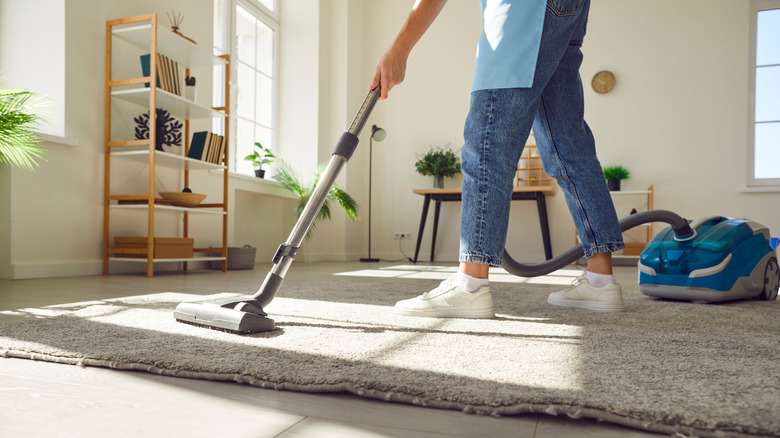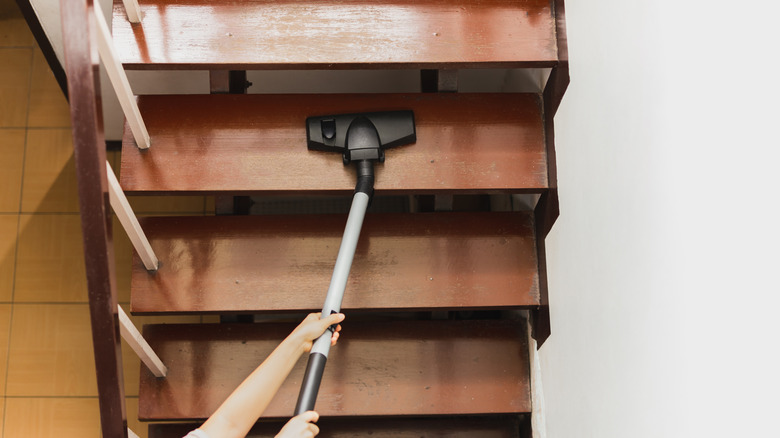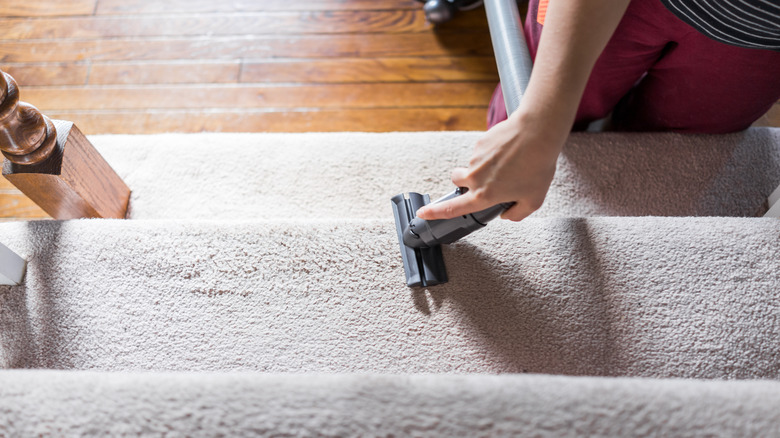Avoid A Common Vacuuming Mistake For A Cleaner Home
We may receive a commission on purchases made from links.
While vacuuming is a pretty straightforward task, there are some mistakes you could be making. A common error is not vacuuming your stairs enough. Since staircases are some of the most high-traffic areas in the home, they can quickly accumulate dust and dander. To avoid debris from piling up, giving regular attention to your stairs is best. However, most people neglect this task, since it's typically more labor-intensive than other types of vacuuming. Still, you should take a vacuum to your stairs weekly to clean the area thoroughly for a healthier and safer home.
Both carpet and hardwood stairs require vacuuming, especially if you have pets or your home is prone to dust. Cleaning your house can take significant effort, and it can often be a hassle to clean stairs. It's necessary, however, because ignoring dust buildup can make wood stair surfaces slippery, increasing fall risks. Though creating a safer surface for kids and the elderly is a good reason why you should add carpet to a staircase, one disadvantage is that dust accumulation in carpeted stairs can lead to increased allergies or respiratory issues. So, determine for yourself whether hardwood or carpet stairs are best for you.
Not only are vacuums often unwieldy and hard to carry up the stairs, but outlets may often be in hard-to-reach areas for vacuums that require a plug. Using an extension cord is a possible solution, yet this also presents a tripping hazard for you and your family. A better solution is to find a cordless vacuum that works for your needs so you don't let the little dust bunnies grow into dust rabbits.
How to vacuum stairs properly
The good news is that vacuuming your stairs doesn't have to be a dreaded chore if you do it weekly. Use a lightweight vacuum that will let you complete the task on a full charge. Many think cordless vacuums are worth the hype as they eliminate the need to fuss with a long cord. They're also safer to maneuver while you are on the stairs. Most cord-free options like the Bissell Cleanview XR Pet 300W Cordless Vacuum or the BLACK+DECKER POWERSERIES+ 20V MAX Cordless Stick Vacuum are suitable for both carpet and hardwood, so you can bust the dust without worrying about damaging your floors. If you already own a stick vacuum, double check the manufacturer notes to ensure it's safe for multiple floor types.
Before you start vacuuming, assess the stairs and pick up large debris or objects that might be on the floor. You might hoover up a Barbie shoe or a hair tie if you aren't careful! Next, use a microfiber cloth or mop to remove what dust you can. Once you get in the habit of weekly vacuuming, you probably won't have to repeatedly do this step because there won't be as much accumulation. Always start at the top of the stairs and work your way down, so any dust and dander you stir falls down below so you can vacuum it later. Push the vacuum back and forth, making sure you remove all of the dust buildup. Once you finish, you should have a cleaner floor, but if you want a true clean, break out the attachments to really amp it up.
Extra tips for taking care of your stairs
Many vacuums come with accessories or attachments meant for certain jobs. For the best results, you need to perform the right tasks for your vacuum attachments. As you vacuum your stairs, consider using the crevice tool to get into the tight nooks and crannies. An extension wand is also a good choice because it extends your reach, letting you vacuum quicker if you're pressed for time. Dander and pet hair can be particularly stubborn, especially if you have carpeted stairs, so choose a brush attachment to thoroughly remove anything trapped in the carpet.
If you have carpet stairs, you can also go a bit further by sprinkling baking soda to deodorize and refresh them. It's best to let the baking soda sit for at least 15 minutes before vacuuming so it has time to absorb into the carpet. You can also minimize the dust buildup on your wooden stairs by applying varnish, if you haven't already, to help resist dust. A varnish treatment helps fill the wood's pores to provide less spaces for dust and dander to settle. To ensure this doesn't create a slippery (and therefore dangerous) finish, look for varnishes with anti-slip properties.


